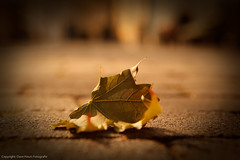One Clover & A Bee: Poetry that Engages the Senses
The Sound of One Leaf Falling
 Some poems are clearly meant to be read aloud: sound is the engine that moves them off the page and into our consciousness. Other poems rely more on image, making pictures that resonate in our mind’s eye.
Some poems are clearly meant to be read aloud: sound is the engine that moves them off the page and into our consciousness. Other poems rely more on image, making pictures that resonate in our mind’s eye.
Some poems try to do both, using structural elements like line breaks, punctuation and white space to guide the reader through the poem, encouraging us to move slowly, linger on an image or sound, or speed up, rush through a phrase with held breath.
This Leaf, by Beatrice Schenk de Regniers is one those poems that wants to engage the reader/listener on all levels. It’s a poem about seeing, hearing and feeling, and although it’s short and written in simple language, the way those words are laid out on the page make a big impact on how we read and say the poem.
This Leaf
by Beatrice Schenk de Regniers
This leaf
once
touched
the
sky.
Now it is
dry
crumbs
under my feet.
I
must be
a
Giant.
For young readers, seeing a poem on the page that makes use of these tricks can be exciting, but also confusing—how am I supposed to read this? Why doesn’t it look a regular sentence that everybody tells me I need to learn how to read and write?
You can have fun with your kids learning how to say this poem together. Read it through once, silently, pretend the line breaks are yellow traffic lights–make sure you pause when the lines stops! Why? because the writer wants you to rest a while in that image or sound. Stay in that idea.
Then move on.
When you get to a period, it’s a red light. Take a full breath and feel your heart beat. Something is about to shift, get ready!
Then move on.
When you come to the very end of the poem, stay a while longer, take in what you’ve seen and felt, then read it again! Each time you do, the rhythm will feel more natural, the pauses less awkward, and your understanding of the poem will deepen.
I love how the short lines force me to slow down; it echoes the intense focus that young children have, and that we adults can lose as we hurry through one experience to the next. It’s like what the painter Georgia O’Keeffe said about her work:
“When you take a flower in your hand and really look at it, it’s your world for the moment. I want to give that world to someone else.”
The world of this poem—this leaf, not just any leaf—spoken through the consciousness of a child, is at once very large and very small, awe-inducing and conquerable.
Excuse me, while I touch the sky.
ABOUT THE AUTHOR
Amy’s the mother of two children who seem to enjoy poetry, for which she’s extremely grateful. Her first book, How I Got Lost So Close To Home, was published by Alice James Books and poems have appeared in a variety of anthologies and journals. She’s a former Associate at the Five College Women’s Studies Research Center at Mt. Holyoke College, where she looked at the impact of motherhood on the work of women poets. In addition to her life as a poet, Dryansky works for a land trust, teaches in at Hampshire College, leads workshops in the community and writes about what it’s like to navigate the territory of mother/poet/worker at her blog, Pokey Mama. Her second book, Grass Whistle, is forthcoming from Salmon Poetry in 2013.
[Photo credit: (ccl) Dave Heuts]
 Hilltown Families
Hilltown Families 






























